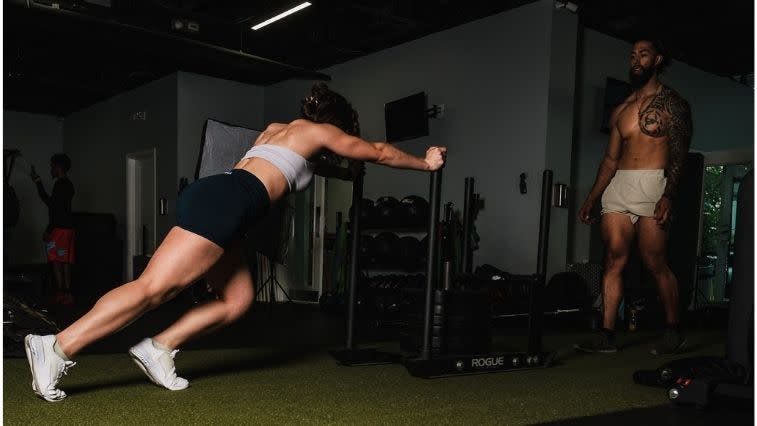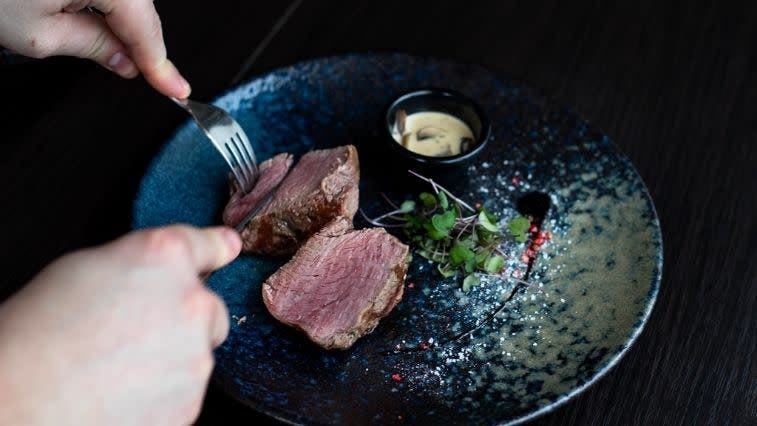How to Build Killer Calves (With or Without a Gym!)
Our content strives to support, inform, and motivate you to meet your health goals. We want to be your trusted source of expert- and science-backed info dispensed in simple, actionable ways. Read our Editorial Guidelines.
Whether you’re looking to tone them down or beef them up, the calves have a reputation for stubbornly resisting efforts to shape them.
The calf is a notoriously tricky muscle to build, and we have long laid the blame on the door of genetics. Anyone else guilty of blaming their parents for “tiny calf genes”?
Turns out, the calves are just like any other muscle. While genetics inherently play a role in the muscle’s development, there is no scientific reason to believe that genetic barriers cannot be overcome with a regimented training plan and proper diet.
In fact, one study found that the calf muscles respond “robustly” to resistance training regardless of genetic factors, such as muscle fiber type composition.
So, if you weren’t genetically blessed with Herculean calves, fear not! You still have control over your training and fueling plan, and these factors matter just as much, if not more, than your genes.
My experience as a certified personal trainer as well as recent developments in research are testaments that building and toning your calf muscles can be accomplished with a training and nutrition plan that is specifically tailored for the calves.
Training Regimen
While the fundamentals of muscle-building always apply, the calves are a unique set of muscles, demanding a nuanced approach to training.
Let’s dive into some essential characteristics of a good calf muscle-building plan.
Sets & Reps

According to a 2019 review, you should aim for 12–28 sets per muscle each week to maximize muscle growth.
Now, how you distribute those sets throughout the week is up to you. Because your calves are primarily composed of slow-twitch muscle fibers that are constantly activated at a low level every day simply from walking, you can train them more frequently than other muscles.
I recommend training your calves at least two times, but no more than five times each week, for the best results.
Higher rep ranges are widely believed to be superior for this particular muscle. According to Charlie Ottinger, certified exercise physiologist and strength and conditioning specialist, a muscle such as the calf, which has a high density of slow-twitch fibers, likely requires more time under tension to grow. He recommends that most of your calf exercises are done in the 15- to 30-rep range.
On the other hand, a 2020 study found that both heavy (6–10 reps) and light (20–30 reps) load training programs resulted in significant increases in calf mass.
Based on these findings and my own experience, I recommend varying your rep ranges but skewing toward the higher end of the rep range spectrum. Don’t overthink it!
It’s also important that you increase the difficulty level of each exercise as they start to feel easier in order to progressively overload the muscle — a process critical to the hypertrophy of any muscle.
For example, if you did 10 reps of calf raises with 25 pounds in your previous workout, I would recommend either trying an extra five pounds or aiming for a couple more reps at the same weight.
And if you’re not seeing results, try increasing volume by adding more sets each week.
Weight
The growth of any muscle is stimulated when the muscle is under sufficient tension, and our calves are no different. In order to grow, adequate resistance must be applied to the calf, whether by dumbbells, a machine, or even your bodyweight.
So, when you train calves, make sure that the last few reps of every set are pretty challenging to ensure sufficient stimulation.
Years ago, a client came to me with high calf-building aspirations. Upon assessing his approach to achieving this goal in the past, it was clear that he was not loading the muscle nearly enough to see the type of results he was looking for.
So, we incorporated exercises that allowed for greater resistance. In just two months, the measured circumference of his calves were increasing.
Range of Motion
Another variable that’s particularly important for building the calves but is often overlooked is range of motion (ROM).
Because ankle flexion and extension are relatively small movements, it’s easy to quite literally bounce through a set of calf raises, inadvertently under-stimulating the muscle. The exercise becomes immensely more effective with full, controlled reps.
One systematic review concluded that performing exercises through full ROM is superior to training with partial ROM for hypertrophy of the lower body.
In order to achieve full ROM, the calf should be stretched as deeply as possible at the bottom of the movement and then contracted until you’re on your tiptoes at the top. Be sure to pause for one to two seconds at the bottom and top of each rep to ensure full ROM.
Personally, I like to repeat in my head, “Stretch… one… two… squeeze… one… two.” Focusing on getting full ROM was a game changer for my calf gains.
Exercises

Even more so than other muscles, the calf requires exercises that specifically target and isolate it in order to grow. Lower body compound movements like squats and deadlifts won’t do the trick!
The calf is made up of two muscles: the gastrocnemius and the soleus. So, we need to include a variety of exercises in order to develop the whole calf.
These exercises broadly fall into two categories:
ones in which the leg is straight (standing and leg press calf raises), which primarily work the gastroc
ones in which the leg is bent (seated calf raises), which primarily target the soleus.
Let’s get into a few examples of each.
Standing Calf Raises
Beginner
Intermediate
A platform, box, stacked weight plates, or another sturdy elevated surface can be used to achieve elevation.
Advanced
At Home
If you don’t have access to a gym, the beginner and intermediate variations of this exercise can easily be done at home.
For the elevated variation, I recommend using a stair step, but you can also use a sturdy stool or other elevated surface that allows a full stretch at the bottom of the movement.
You can also add dumbbells for extra resistance if you have them. If not, just do more reps.
Standing Single-leg Calf Raises
Beginner
Intermediate
Advanced
At Home
Again, the beginner and intermediate variations of this exercise can easily be done at home with or without dumbbells!
And for the elevated variation, you can use a stair step, stool or other sturdy elevated surface.
Leg Press Calf Raises
This is the most advanced variation of a straight-legged calf raise, so I recommend that beginners start off with the exercises above before trying this one.
Intermediate
Advanced
You can also utilize different foot positions with these straight-legged exercises in order to target specific parts of the gastroc. A recent study found that performing calf raises with the toes pointed outward results in greater increases in muscle mass of the inner part of the gastroc, while pointing the toes inward provides greater growth of the outer part of the muscle.
Seated Calf Raises
All Levels
All experience levels are safe to use this exercise, but make sure to start off with no added weight if you’re trying it for the first time.
At Home
At home, you can use a chair or couch for your seat and a stair step, stool, or other sturdy surface for the elevated variations.
If you’re looking to strengthen your calves for sports, you may want to also add some plyometric and agility drills that promote explosiveness:
Sprints and shuttle runs
Diet

It would be remiss of me not to mention the importance of diet, particularly protein intake, in the building of calf muscle.
For deep-dive tips on how to increase your protein intake, as well as the best supplements for muscle growth in general, check out my article: How Long It Takes (& What It Takes) To Build Muscle.
In short, you should aim for 1.6–2.2 grams of protein per kilogram of bodyweight daily to support muscle repair and growth.
For optimal results, I recommend spreading your protein intake throughout the day and consuming 20–30g one to two hours before or after your workouts.
A hardworking client of mine with muscle-building goals spent months crushing it in the gym: training calves three times a week, lifting heavy, and doing all the right exercises. But, he struggled to reach his protein target, which hindered his progress.
So, together we made a list of foods he frequently ate along with a list of high-protein alternatives. Just a few swaps and the addition of a daily protein shake got him to his target. After a couple months, he began seeing growth in his calves (and the rest of his body).
Gender Differences
Most people associate men with greater strength and muscle size compared to women.
Fair enough! Due to physiological variance, it’s true that men tend to be stronger and have more muscle than women.
Women just don’t have as much muscle or strength to begin with. Plus, they’re not as likely to strength train (let’s change that ladies!).
The idea that female bodies don’t have the same capacity for increasing muscle mass and strength conflicts with recent research. Here’s what the science says:
A 2021 study found similar increases in both muscle mass and strength between males and females in response to resistance training.
In another study, men and women saw strength and muscle thickness increases of comparable size and in about the same amount of time.
A 2020 meta-analysis found that males and females respond to strength training with similar levels of lower-body strength and hypertrophy.
In other words, a man may have a higher baseline level of strength and muscle mass, but a woman is just as capable of increasing either measure by any given percentage.
So, should men and women follow the same training principles to build and strengthen their calves?
Pretty much! As long as you’re training with sufficient weight, volume, and range of motion and consuming enough protein, you can achieve your killer calf dreams!
Let’s Get Started
Here are three things you can do right now to get started:
Write down your new workout schedule along with the calf exercises you’d like to include.
Calculate your protein target.
Schedule a free consultation with a Kickoff trainer, who can help you create the perfect muscle-building plan for you.